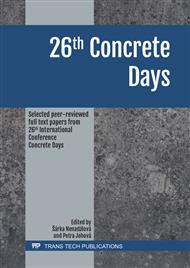[1]
Brandt, A.M. Fibre reinforced cement-based (FRC) composites after over 40 years of development in building and civil engineering. Composite Structures. 2008, 86 (1-3), pp.3-9.
DOI: 10.1016/j.compstruct.2008.03.006
Google Scholar
[2]
Marcalíková, Z., Procházka, L., Pešata, M., Boháčová, J., Čajka, R. Comparison of material properties of steel fiber reinforced concrete with two types of steel fiber. IOP Conference Series: Materials Science and Engineering. 2019, 549 (1), art. no. 012039.
DOI: 10.1088/1757-899x/549/1/012039
Google Scholar
[3]
Sucharda, O., Bilek, V., Smirakova, M., Kubosek, J., Cajka, R., Comparative Evaluation of Mechanical Properties of Fibre Reinforced Concrete and Approach to Modelling of Bearing Capacity Ground Slab. Periodica Polytechnica Civil Engineering. 2017, 61, No. 4.
DOI: 10.3311/ppci.10688
Google Scholar
[4]
di Prisco, M. , Colombo, M. and Dozio, D. Fibre‐reinforced concrete in fib Model Code 2010: principles, models and test validation. Structural Concrete. 2013, 14, pp.342-361.
DOI: 10.1002/suco.201300021
Google Scholar
[5]
Test Method for Metallic Fibre Concrete - Measuring the Flexural Tensile Strength (Limit of Proportionality (LOP), Residual) CEN European Commit-439 Tee for Standardization 440, EN 14651:2005+A1:2007(E).
DOI: 10.3403/30092475
Google Scholar
[6]
Rilem TC 162-TDF: Test and design methods for steel fibre reinforced concrete - Bending test, Materials and Structures/Materiaux et Constructions. 2002, 35 (253), pp.579-582.
DOI: 10.1617/13884
Google Scholar
[7]
DAfStb guidelines, 2011: DAfStb-Richtlinie Stahlfaserbeton. Deutscher Ausschuss für Stahlbeton - DAfStb, Berlin, German. (In German).
DOI: 10.1002/best.200900067
Google Scholar
[8]
TP FC 1-1 Technical conditions 1: Fiber concrete - Part 1: Testing of fiber concrete, evaluation of destructive tests and determination of a characteristic working diagram of fiber reinforced concrete for the design of fiber reinforced concrete structures; Czech Technical University in Prague, Faculty of Civil Engineering, Department of Concrete and Masonry Structures, Praha 2007 (In Czech).
DOI: 10.14359/5699
Google Scholar
[9]
Singh, H. Steel Fiber Reinforced Concrete. Springer Transactions in Civil and Environmental Engineering, 172 p., 2017,.
Google Scholar
[10]
Katzer, J., Domski, J. Quality and mechanical properties of engineered steel fibres used as reinforcement for concrete. Construction and Building Materials. 2012, 34, pp.243-248.
DOI: 10.1016/j.conbuildmat.2012.02.058
Google Scholar
[11]
Ponikiewski, T., Katzer, J., Fresh mix characteristics of self-compacting concrete reinforced by fibre. Periodica Polytechnica Civil Engineering. 2017, 61 (2), pp.226-231.
DOI: 10.3311/ppci.9008
Google Scholar
[12]
Marcalikova, Z., Prochazka, L., Pesata, M., Bilek, V., Cajka, R. Mechanical properties of concrete with small fibre for numerical modelling. IOP Conference Series: Materials Science and Engineering. 2019, 596 (1), art. no. 012036,.
DOI: 10.1088/1757-899x/596/1/012036
Google Scholar
[13]
Kormaníková, E., Kotrasová, K. Elastic mechanical properties of fiber reinforced composite materials. Chemicke Listy. 2011, 105 (17), pp.758-762.
Google Scholar
[14]
Cervenka, V., Jendele, L., Cervenka, J. ATENA Program Documentation - Part 1: Theory, Cervenka Consulting. Pratur, (2007).
Google Scholar
[15]
Cervenka, V., Cervenka, J., 2002. ATENA – A Tool for Engineering Analysis of Fracture in Concrete. Sadhana 27(August), p.485–92.
DOI: 10.1007/bf02706996
Google Scholar
[16]
Kubosek, J. Nonlinear analysis of reinforced concrete structures, Diploma thesis, VŠB-TU Ostrava. (2015).
Google Scholar
[17]
Augustín, T., Fillo, Ľ., Halvonik, J. Nonlinear fem analysis of experimentally tested flat slabs with openings. Solid State Phenomena. 2019, 292, pp.191-196.
DOI: 10.4028/www.scientific.net/ssp.292.191
Google Scholar
[18]
Sokol, M., Márföldi, M., Venglár, M., Lamperová, K. Evaluation of performance indicator of railway bridges using updated finite element model. Strojnicky Casopis. 2019, 69 (2), pp.89-96.
DOI: 10.1063/5.0031074
Google Scholar
[19]
Králik, J. Nonlinear probabilistic analysis of the reinforced concrete structure failure of a nuclear power plant considering degradation effects. Applied Mechanics and Materials. 2013, 249-250, pp.1087-1098.
DOI: 10.4028/www.scientific.net/amm.249-250.1087
Google Scholar
[20]
http://www.bekaert.com/en/products/construction/concrete-reinforcement.
Google Scholar


